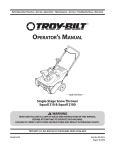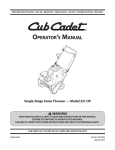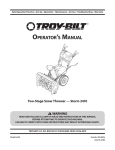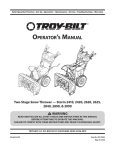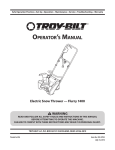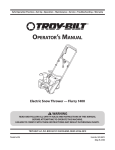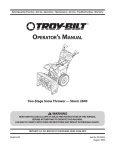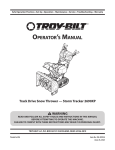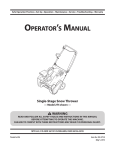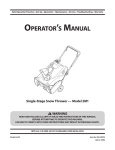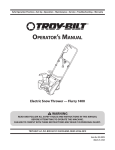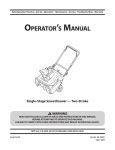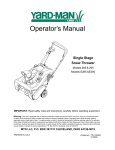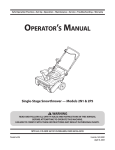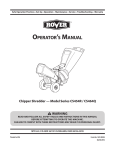Download Troy-Bilt 769-08234 User's Manual
Transcript
Safe Operation Practices • Set-Up • Operation • Maintenance • Service • Troubleshooting • Warranty Operator’s Manual — Squall 2100 Shown — Single-Stage Snow Thrower Squall 210 & Squall 2100 WARNING READ AND FOLLOW ALL SAFETY RULES AND INSTRUCTIONS IN THIS MANUAL BEFORE ATTEMPTING TO OPERATE THIS MACHINE. FAILURE TO COMPLY WITH THESE INSTRUCTIONS MAY RESULT IN PERSONAL INJURY. TROY-BILT LLC, P.O. BOX 361131 CLEVELAND, OHIO 44136-0019 Printed In USA Form No. 769-08234 (May 24, 2012) 1 To The Owner Thank You Thank you for purchasing a Troy-Bilt Snow Thrower. It was carefully engineered to provide excellent performance when properly operated and maintained. If applicable, the power testing information used to establish the power rating of the engine equipped on this machine can be found at www.opei.org or the engine manufacturer’s web site. Please read this entire manual prior to operating the equipment. It instructs you how to safely and easily set up, operate and maintain your machine. Please be sure that you, and any other persons who will operate the machine, carefully follow the recommended safety practices at all times. Failure to do so could result in personal injury or property damage. If you have any problems or questions concerning the machine, phone a authorized Troy-Bilt service dealer or contact us directly. Troy-Bilt’s Customer Support telephone numbers, website address and mailing address can be found on this page. We want to ensure your complete satisfaction at all times. All information in this manual is relative to the most recent product information available at the time of printing. Review this manual frequently to familiarize yourself with the machine, its features and operation. Please be aware that this Operator’s Manual may cover a range of product specifications for various models. Characteristics and features discussed and/or illustrated in this manual may not be applicable to all models. We reserve the right to change product specifications, designs and equipment without notice and without incurring obligation. Throughout this manual, all references to right and left side of the machine are observed from the operating position Table of Contents Safe Operation Practices......................................... 3 Assembly & Set-Up................................................... 7 Controls & Features................................................10 Operation.................................................................12 Maintenance & Adjustment..................................13 Service......................................................................15 Troubleshooting......................................................17 Replacement Parts..................................................18 Warranties.............................................................. 20 Record Product Information Model Number Before setting up and operating your new equipment, please locate the model plate on the equipment and record the information in the provided area to the right. You can locate the model plate by standing at the operator’s position and looking down at the right rear of the snow thrower. This information will be necessary, should you seek technical support via our web site, Customer Support Department, or with a local authorized service dealer. Serial Number Customer Support Please do NOT return the machine to the retailer or dealer without first contacting the Customer Support Department. If you have difficulty assembling this product or have any questions regarding the controls, operation, or maintenance of this machine, you can seek help from the experts. Choose from the options below: ◊ Visit us on the web at www.troybilt.com See How-to Maintenance and Parts Installation Videos at www.troybilt.com/tutorials 2 ◊ Call a Customer Support Representative at (800) 828-5500 or (330) 558-7220 ◊ Write to Troy-Bilt LLC • P.O. Box 361131 • Cleveland, OH • 44136-0019 Important Safe Operation Practices 2 WARNING! This symbol points out important safety instructions which, if not followed, could endanger the personal safety and/or property of yourself and others. Read and follow all instructions in this manual before attempting to operate this machine. Failure to comply with these instructions may result in personal injury. When you see this symbol. HEED ITS WARNING! CALIFORNIA PROPOSITION 65 WARNING! Engine Exhaust, some of its constituents, and certain vehicle components contain or emit chemicals known to State of California to cause cancer and birth defects or other reproductive harm. DANGER: This machine was built to be operated according to the safe operation practices in this manual. As with any type of power equipment, carelessness or error on the part of the operator can result in serious injury. This machine is capable of amputating fingers, hands, toes and feet and throwing foreign objects. Failure to observe the following safety instructions could result in serious injury or death. Training Preparation 1. Read, understand, and follow all instructions on the machine and in the manual(s) before attempting to assemble and operate. Keep this manual in a safe place for future and regular reference and for ordering replacement parts. Thoroughly inspect the area where the equipment is to be used. Remove all doormats, newspapers, sleds, boards, wires and other foreign objects, which could be tripped over or thrown by the auger/impeller. 2. Be familiar with all controls and their proper operation. Know how to stop the machine and disengage them quickly. 3. 1. Always wear safety glasses or eye shields during operation and while performing an adjustment or repair to protect your eyes. Thrown objects which ricochet can cause serious injury to the eyes. Never allow children under 14 years of age to operate this machine. Children 14 and over should read and understand the instructions and safe operation practices in this manual and on the machine and be trained and supervised by an adult. 2. Do not operate without wearing adequate winter outer garments. Do not wear jewelry, long scarves or other loose clothing, which could become entangled in moving parts. Wear footwear which will improve footing on slippery surfaces. 4. Never allow adults to operate this machine without proper instruction. 3. Use a grounded three-wire extension cord and receptacle for all machines with electric start engines. 5. Thrown objects can cause serious personal injury. Plan your snow-throwing pattern to avoid discharge of material toward roads, bystanders and the like. 4. Disengage all control levers before starting the engine. 5. Never attempt to make any adjustments while engine is running, except where specifically recommended in the operator’s manual. 6. Let engine and machine adjust to outdoor temperature before starting to clear snow. 6. 7. Keep bystanders, pets and children at least 75 feet from the machine while it is in operation. Stop machine if anyone enters the area. Exercise caution to avoid slipping or falling, especially when operating in reverse. 3 Safe Handling of Gasoline 5. To avoid personal injury or property damage use extreme care in handling gasoline. Gasoline is extremely flammable and the vapors are explosive. Serious personal injury can occur when gasoline is spilled on yourself or your clothes which can ignite. Wash your skin and change clothes immediately. Never run an engine indoors or in a poorly ventilated area. Engine exhaust contains carbon monoxide, an odorless and deadly gas. 6. Do not operate machine while under the influence of alcohol or drugs. 7. Muffler and engine become hot and can cause a burn. Do not touch. Keep children away. a. Use only an approved gasoline container. b. Extinguish all cigarettes, cigars, pipes and other sources of ignition. 8. Exercise extreme caution when operating on or crossing gravel surfaces. Stay alert for hidden hazards or traffic. c. Never fuel machine indoors. 9. d. Never remove gas cap or add fuel while the engine is hot or running. Exercise caution when changing direction and while operating on slopes. Do not operate on steep slopes. 10. e. Allow engine to cool at least two minutes before refueling. Plan your snow-throwing pattern to avoid discharge towards windows, walls, cars etc. Thus, avoiding possible property damage or personal injury caused by a ricochet. f. Never over fill fuel tank. Fill tank to no more than ½ inch below bottom of filler neck to provide space for fuel expansion. 11. Never direct discharge at children, bystanders and pets or allow anyone in front of the machine. 12. Do not overload machine capacity by attempting to clear snow at too fast of a rate. 13. Never operate this machine without good visibility or light. Always be sure of your footing and keep a firm hold on the handles. Walk, never run. 14. Disengage power to the auger/impeller when transporting or not in use. 15. Never operate machine at high transport speeds on slippery surfaces. Look down and behind and use care when backing up. g. Replace gasoline cap and tighten securely. h. If gasoline is spilled, wipe it off the engine and equipment. Move machine to another area. Wait 5 minutes before starting the engine. i. Never store the machine or fuel container inside where there is an open flame, spark or pilot light (e.g. furnace, water heater, space heater, clothes dryer etc.). j. Allow machine to cool at least 5 minutes before storing. 16. k. Never fill containers inside a vehicle or on a truck or trailer bed with a plastic liner. Always place containers on the ground away from your vehicle before filling. If the machine should start to vibrate abnormally, stop the engine, disconnect the spark plug wire and ground it against the engine. Inspect thoroughly for damage. Repair any damage before starting and operating. 17. If possible, remove gas-powered equipment from the truck or trailer and refuel it on the ground. If this is not possible, then refuel such equipment on a trailer with a portable container, rather than from a gasoline dispenser nozzle. Disengage all control levers and stop engine before you leave the operating position (behind the handles). Wait until the auger/impeller comes to a complete stop before unclogging the chute assembly, making any adjustments, or inspections. 18. Never put your hand in the discharge or collector openings. Do not unclog chute assembly while engine is running. Shut off engine and remain behind handles until all moving parts have stopped before unclogging. 19. Use only attachments and accessories approved by the manufacturer (e.g. wheel weights, tire chains, cabs etc.). 20. When starting engine, pull cord slowly until resistance is felt, then pull rapidly. Rapid retraction of starter cord (kickback) will pull hand and arm toward engine faster than you can let go. Broken bones, fractures, bruises or sprains could result. 21. If situations occur which are not covered in this manual, use care and good judgment. Contact Customer Support for assistance and the name of your nearest servicing dealer. l. m. Keep the nozzle in contact with the rim of the fuel tank or container opening at all times until fueling is complete. Do not use a nozzle lock-open device. Operation 4 1. Do not put hands or feet near rotating parts, in the auger/ impeller housing or chute assembly. Contact with the rotating parts can amputate hands and feet. 2. The auger/impeller control lever is a safety device. Never bypass its operation. Doing so makes the machine unsafe and may cause personal injury. 3. The control levers must operate easily in both directions and automatically return to the disengaged position when released. 4. Never operate with a missing or damaged chute assembly. Keep all safety devices in place and working. Section 2 — Important Safe Operation Practices Clearing a Clogged Discharge Chute Hand contact with the rotating impeller inside the discharge chute is the most common cause of injury associated with snow throwers. Never use your hand to clean out the discharge chute. To clear the chute: 1. SHUT THE ENGINE OFF! 2. Wait 10 seconds to be sure the impeller blades have stopped rotating. 3. Always use a clean-out tool, not your hands. Maintenance & Storage 1. Never tamper with safety devices. Check their proper operation regularly. Refer to the maintenance and adjustment sections of this manual. 2. Before cleaning, repairing, or inspecting machine disengage all control levers and stop the engine. Wait until the auger/impeller come to a complete stop. Disconnect the spark plug wire and ground against the engine to prevent unintended starting. 3. Check bolts and screws for proper tightness at frequent intervals to keep the machine in safe working condition. Also, visually inspect machine for any damage. 4. Do not change the engine governor setting or over-speed the engine. The governor controls the maximum safe operating speed of the engine. 5. Snow thrower shave plates and skid shoes are subject to wear and damage. For your safety protection, frequently check all components and replace with original equipment manufacturer’s (OEM) parts only. “Use of parts which do not meet the original equipment specifications may lead to improper performance and compromise safety!” 6. Check control levers periodically to verify they engage and disengage properly and adjust, if necessary. Refer to the adjustment section in this operator’s manual for instructions. 7. Maintain or replace safety and instruction labels, as necessary. 8. Observe proper disposal laws and regulations for gas, oil, etc. to protect the environment. 9. Prior to storing, run machine a few minutes to clear snow from machine and prevent freeze up of auger/impeller. 10. Never store the machine or fuel container inside where there is an open flame, spark or pilot light such as a water heater, furnace, clothes dryer etc. 11. Always refer to the operator’s manual for proper instructions on off-season storage. 12. Check fuel line, tank, cap, and fittings frequently for cracks or leaks. Replace if necessary. 13. Do not crank engine with spark plug removed. 14. According to the Consumer Products Safety Commission (CPSC) and the U.S. Environmental Protection Agency (EPA), this product has an Average Useful Life of seven (7) years, or 60 hours of operation. At the end of the Average Useful Life have the machine inspected annually by an authorized service dealer to ensure that all mechanical and safety systems are working properly and not worn excessively. Failure to do so can result in accidents, injuries or death. Do not modify engine To avoid serious injury or death, do not modify engine in any way. Tampering with the governor setting can lead to a runaway engine and cause it to operate at unsafe speeds. Never tamper with factory setting of engine governor. Notice Regarding Emissions Engines which are certified to comply with California and federal EPA emission regulations for SORE (Small Off Road Equipment) are certified to operate on regular unleaded gasoline, and may include the following emission control systems: Engine Modification (EM), Oxidizing Catalyst (OC), Secondary Air Injection (SAI) and Three Way Catalyst (TWC) if so equipped. Spark Arrestor WARNING! This machine is equipped with an internal combustion engine and should not be used on or near any unimproved forest-covered, brush covered or grass-covered land unless the engine’s exhaust system is equipped with a spark arrestor meeting applicable local or state laws (if any). If a spark arrestor is used, it should be maintained in effective working order by the operator. In the State of California the above is required by law (Section 4442 of the California Public Resources Code). Other states may have similar laws. Federal laws apply on federal lands. A spark arrestor for the muffler is available through your nearest engine authorized service dealer or contact the service department, P.O. Box 361131 Cleveland, Ohio 44136-0019. Section 2 — Important Safe Operation Practices 5 Safety Symbols This page depicts and describes safety symbols that may appear on this product. Read, understand, and follow all instructions on the machine before attempting to assemble and operate. Symbol Description READ THE OPERATOR’S MANUAL(S) Read, understand, and follow all instructions in the manual(s) before attempting to assemble and operate WARNING— ROTATING BLADES Keep hands out of inlet and discharge openings while machine is running. There are rotating blades inside WARNING— ROTATING BLADES Keep hands out of inlet and discharge openings while machine is running. There are rotating blades inside WARNING— ROTATING AUGER Do not put hands or feet near rotating parts, in the auger/impeller housing or chute assembly. Contact with the rotating parts can amputate hands and feet. WARNING—THROWN OBJECTS This machine may pick up and throw and objects which can cause serious personal injury. WARNING—GASOLINE IS FLAMMABLE Allow the engine to cool at least two minutes before refueling. WARNING— CARBON MONOXIDE Never run an engine indoors or in a poorly ventilated area. Engine exhaust contains carbon monoxide, an odorless and deadly gas. WARNING— ELECTRICAL SHOCK Do not use the engine’s electric starter in the rain WARNING— HOT SURFACE Engine parts, especially the muffler, become extremely hot during operation. Allow engine and muffler to cool before touching. WARNING! Your Responsibility—Restrict the use of this power machine to persons who read, understand and follow the warnings and instructions in this manual and on the machine. SAVE THESE INSTRUCTIONS! 6 Section 2 — Important Safe Operation Practices 3 Assembly & Set-Up Contents of Carton • One Snow Thrower • One 20 oz. Bottle 5W-30 Oil • Two Ignition Keys • One Chute Assembly • One Chute Rotation Control (If equip.) • One Set of Drift Cutters (If equip.) • One Electric Starter Cord (If equip.) • One Snow Thrower Operator’s Manual • NOTE: This Operator’s Manual covers several models. Snow thrower features may vary by model. Not all features in this manual are applicable to all snow thrower models and the snow thrower depicted may differ from yours. 2. One Engine Operator’s Manual Pivot the upper handle into the operating position. Be sure not to pinch any of the cables in the process. See Figure 3-2. NOTE: All references to the left or right side of the snow thrower are from the operator’s position. Any exceptions will be noted. Tools Required • • One 5/16-inch wrench (or adjustable wrench) • • One 1/2-inch wrench (or adjustable wrench) Assembly Positioning the Upper Handle 1. Remove the wing knob and carriage bolt from the top of the lower handle. See Figure 3-1. It is not necessary to remove the shoulder screw and flange lock nut below the wing knob and carriage bolt. Wing Knob Figure 3-2 Installing the Chute Carriage Bolts 1. Wing Knob Remove the hex washer screws in the chute base. See Figure 3-3. Figure 3-1 Figure 3-3 7 2. Align the holes in the chute base with the holes in the lower chute and secure with the previously removed hex washer screws. See Figure 3-4. Installing the Drift Cutters (If so equipped) 1. Remove the carriage bolts and flange lock nuts from the drift cutters. 2. Install the drift cutters and secure with the carriage bolts and flange lock nuts removed in step 1. See Figure 3-6. Drift Cutter Flange Lock Nut Carriage Bolt Figure 3-4 Installing the Chute Rotation Control (If so equipped) To install the chute rotation control (only models so equipped) proceed as follows: 1. Remove the hex lock nut and machine screw from the chute rotation control. See Figure 3-5. Figure 3-6 Installing the Recoil Starter Handle 1. Remove the eye bolt and handle knob from the manual bag. 2. Place the eye bolt and handle knob on the upper handle as shown in Figure 3-7. Do not fully tighten the hardware until instructed to do so. 1 Chute Rotation Control Hex Lock Nut Machine Screw Eye Bolt Recoil Starter Handle 2 Hex Lock Nut Chute Control Rod Machine Screw Figure 3-5 2. Place the chute rotation control onto the chute rotation rod and secure with the hex lock nut and machine screw removed in step 1. See Figure 3-5. A Handle Knob B Figure 3-7 NOTE: The opening of the eye bolt should face toward the back of the snow thrower. 8 Section 3— Assembly & Set-Up 3. Slowly pull the recoil starter handle up towards the eye bolt. 4. Slip the recoil starter rope into the eye bolt from the back of the snow thrower. See Figure 3-7. 5. Securely tighten the eye bolt and handle knob. Set-Up Adding Oil Refer to the Engine Operator’s Manual packed with your snow thrower for information on adding and checking oil. Adding Fuel Refer to the Engine Operator’s Manual packed with your snow thrower for information on adding fuel. Section 3 — Assembly & Set-Up 9 4 Controls & Features Auger Control Recoil Starter Handle Chute Rotation Control EZ Chute Low-Crank Chute Assembly Drift Cutters Auger Shave Plate NOTE: This Operator’s Manual covers several models. Snow thrower features may vary by model. Not all features in this manual are applicable to all snow thrower models and the snow thrower depicted may differ from yours. Engine Controls See the Engine Operator’s Manual for the location and function of the controls on the engine. Auger When engaged, the auger rotation draws snow into the auger housing and throws it out the discharge chute. Rubber paddles on the auger also aid in propelling the snow thrower as they come in contact with the pavement. Auger Control Located on the upper handle, the auger control is used to engage and disengage drive to the auger. Squeeze the control against the upper handle to engage the auger; release it to disengage. 10 Chute Assembly EZ Chute (If so equipped) Rotate the discharge chute to the left or right using the chute handle. The pitch of the discharge chute controls the angle at which the snow is thrown. Loosen the wing knob on the side of the discharge chute before pivoting the discharge chute upward or downward. Retighten the knob once the desired position has been achieved. Low-Crank Chute Assembly (If so equipped) Rotate the discharge chute to the left or right using the chute rotation control. The pitch of the discharge chute controls the angle at which the snow is thrown. Loosen the wing knob on the side of the discharge chute before pivoting the discharge chute upward or downward. Retighten the knob once the desired position has been achieved. Shave Plate The shave plate maintains contact with the pavement as the snow thrower is propelled, allowing snow close to the pavement’s surface to be discharged. Recoil Starter Handle The recoil starter handle is used to manually start the engine. Chute Rotation Control (If so equipped) The chute rotation control is located on the back of the snow thrower. To rotate the chute to the left, squeeze the lever against the chute rotation control and rotate left. To rotate the chute to the right, squeeze the lever against the chute rotation control and rotate right. Drift Cutters (If so Equipped) The drift cutters are designed for use in deep snow. Their use is optional for normal snow conditions. Maneuver the snow thrower so that the cutters penetrate a high standing snow drift to assist snow falling into the augers for throwing. Section 4 — Controls & Features 11 5 Operation Starting & Stopping the Engine WARNING! Always keep hands and feet clear of Low-Crank Chute Assembly (If so equipped) 1. moving parts. Do not use a pressurized starting fluid. Vapors are flammable. Rotate the discharge chute to the left or right using the chute rotation control. See Figure 5-2. Chute Control Handle Refer to the Engine Operator’s manual packed with your snow thrower for instructions on starting and stopping the engine. Engaging the Auger Discharge Chute To engage the auger and start throwing snow, squeeze the auger control against the handle. Release to stop the auger. Engaging the Drive Lift up slightly on the handle to allow the rubber paddles on the auger to contact the pavement and propel the snow thrower forward. Pushing downward on the handle will raise the auger off the ground and stop the forward motion. Wing Knob NOTE: Excessive upward pressure on the handle will result in premature wear on the rubber auger blades which are not be covered by the warranty. Adjusting the Chute Figure 5-2 EZ Chute (If so equipped) 1. 2. Rotate the discharge chute to the left or right using the chute handle. See Figure 5-1. Chute Handle To adjust the pitch, loosen the wing knob on the side of the discharge chute and pivot the discharge chute upward or downward. Retighten the knob once the desired position has been achieved. See Figure 5-2. Clearing a Clogged Discharge Chute Discharge Chute WARNING! Never use your hands to clear a clogged chute assembly. Shut off engine and remain behind handles until all moving parts have stopped before using a clean-out tool to clear the chute assembly. Hand contact with the rotating impeller inside the discharge chute is the most common cause of injury associated with snow throwers. Never use your hand to clean out the discharge chute. To clear the chute: Wing Knob Figure 5-1 2. 12 To adjust the pitch, loosen the wing knob on the side of the discharge chute and pivot the discharge chute upward or downward. Retighten the knob once the desired position has been achieved. See Figure 5-1. 1. SHUT THE ENGINE OFF! 2. Wait 10 seconds to be sure the impeller blades have stopped rotating. 3. Always use a clean-out tool, not your hands. 6 Maintenance & Adjustments Adjustments Auger Control Cable WARNING! Before servicing, repairing or inspecting the snow thrower, disengage the auger control. Stop the engine and remove the key to prevent unintended starting. Shave Plate To check the adjustment of the shave plate, place the machine on a level surface. The wheels, shave plate and auger should all contact the level surface. Note that if the shave plate is adjusted too high, snow may blow under the housing. If the shave plate wears out excessively, or the snow thrower does not self-propel, the shave plate may be too low and needs to be adjusted. As a result of both the auger control cable and the auger drive belt stretching due to wear, periodic adjustments may be necessary. If the auger seems to hesitate when rotating, proceed as follows: The upper hole in the auger control provides for an adjustment in cable tension. To adjust, disconnect the end of control cable from the bottom hole in the auger handle and reinsert it in the upper hole. Insert the cable from the outside as shown in Figure 6-2. NOTE: On new snow throwers or machines with a new shave plate installed, the auger may be slightly off the ground. Control Handle To adjust the shave plate proceed as follows: 1. Drain the gas from the snow thrower. 2. Pull the starter cord until resistance is felt. Then tip the snow thrower back until it rests on the handles. 3. Loosen the four flange lock nuts and carriage screws which secure the shave plate to the housing. See Figure 6-1. Move the shave plate to the desired position and retighten the flange lock nuts and carriage screws securely. Control Cable Side View Carriage Screw Flange Lock Nut Figure 6-2 Test the snow thrower to see if there is a noticeable difference. If after the adjustment to the auger control cable the auger still hesitates when rotating, see the Service section to replace the belt. Chute Assembly Refer to the Operation section for instructions on adjusting the chute assembly. Reversible Shave Plate Figure 6-1 4. Tip the snow thrower back to the operating position and pull the starter handle a few times to see if it is difficult to pull. 5. If the starter is difficult to pull, remove the spark plug and pull the handle several times to ensure that any oil trapped in the head is removed. CAUTION: Oil may come out of the spark plug hole when it is removed and the starter handle is pulled. 6. Inspect the spark plug. If it is wet, clean off any oil before re-installing. 13 Maintenance 3. Lubrication Change the oil and/or the spark plug as instructed in your Engine Operator’s manual. 4. Re-install the lower panel by placing the tabs in the tab slots, lifting the panel into place and secure with the three screws removed in step 2. 5. Tip the snow thrower back to the operating position and pull the starter handle a few times to see if it is difficult to pull. 6. If the starter is difficult to pull, remove the spark plug and pull the handle several times to ensure that any oil trapped in the head is removed. Lubricate the pivot points on the control handle and the extension spring at the end of the control cable with a light oil once every season and before the snow thrower is put into storage at the end of the season. Off-Season Storage If the snow thrower will not be used for 30 days or longer, follow the instructions below. 1. Refer to the Engine Operator’s manual packed with your snow thrower for information on the storage of the engine. 2. Store the equipment in a clean, dry area. 3. If storing in an unventilated area, rustproof the machine using a light oil or silicone to coat the snow thrower. 4. Clean the exterior of the engine and the snow thrower. 5. Lubricate pivot points on control handle and extension spring at end of control cable with a light oil. Engine Refer to the Engine Operators manual packed separately with your snow thrower for maintenance and adjustment information on your engine. 1. To access the oil drain and spark plug on model 2T5 it is necessary to remove the lower panel. 2. Remove the three screws that secure the lower panel. Remove the lower panel by lifting up on the panel to free the tabs at the bottom of the panel from the tab slots and then pull back. See Figure 6-3. Figure 6-3 NOTE: The bottom of the panel has tabs that help hold it in place. NOTE: An oil drain extension kit is available separately. Contact your local Troy-Bilt dealer or contact Troy-Bilt’s Customer Support for kit #753-06684. 14 Section 6— Maintenance & Adjustments CAUTION: Oil may come out of the spark plug hole when it is removed and the starter handle is pulled. 7. Inspect the spark plug. If it is wet, clean off any oil before re-installing. 7 Service Replacing Belt To replace the belt follow these instructions and refer to Figure 7-3: 1. Run the snow thrower until the fuel tank is empty. 2. Pull the recoil starter handle until resistance is felt. Then tip the snow thrower back until it rests on the handles. 3. Slide a board up through the auger and through the chute to secure the auger in place. 4. Remove the belt cover by removing the two hex washer screws and one hex lock screw that secure it to the frame. See Figure 7-1. Drive Pulley Idler Pulley Belt Keeper Hex Lock Screw Flange Nut Auger Pulley Figure 7-3 1. Route the belt around the drive pulley and under the idler pulley. 2. Route the end of the belt around the auger pulley and slide the pulley back on to the auger shaft. It may be necessary to push down on the idler pulley to get the auger pulley under the belt keeper. 3. Replace the flange nut and tighten securely. 4. Reinstall the belt cover removed earlier. 5. Remove the board from the auger and chute. Hex Washer Screw Figure 7-1 5. Remove the flange nut that secures the auger pulley to the auger shaft. See Figure 7-2. Flange Nut Auger Shaft Auger Pulley Figure 7-2 6. Remove the auger pulley and the belt. 15 Replacing Auger Paddles Replacing Shave Plate The snow thrower auger’s rubber paddles are subject to wear and should be replaced if any signs of excessive wear are present. 1. The shave plate is attached to the bottom of the auger housing and is subject to wear. It should be checked periodically. There are two wearing edges and the shave plate can be reversed. 2. Run the snow thrower until the fuel tank is empty. 3. Pull the recoil starter handle until resistance is felt. Then tip the snow thrower back until it rests on the handles. 4. Remove the four carriage bolts and flange lock nuts which attach it to the snow thrower housing. 5. Reverse the existing shave plate or install a new one, making sure the new shave plate and the heads of the carriage bolts are on the inside of the housing. 6. Adjust the shave plate as instructed on page 11. 7. Tighten securely once adjusted. CAUTION: Do NOT allow the auger’s rubber paddles to wear to the point where portions of the metal auger itself can come in contact with the pavement. Doing so can result in serious damage to your snow thrower. To change the rubber paddles, proceed as follows and refer to Figure 7-4: Auger Paddle Hex Washer Screw Hex Washer Screw Figure 7-4 1. Run the snow thrower until the fuel tank is empty. 2. Pull the recoil starter handle until resistance is felt. Then tip the snow thrower back until it rests on the handles. 3. Remove the existing rubber paddles by unthreading the hex washer screws which secure them to the auger. See Figure 7-4. NOTE: The auger paddles should be replaced one at a time so that the auger still attached can be used as an example for positioning and re-installing the new auger. 4. 16 Secure the replacement rubber paddles to the auger using the hardware removed earlier. Section 7— Service 8 Troubleshooting Problem Cause Remedy Excessive vibration 1. Loose parts or damaged auger. 1. Stop engine immediately and disconnect spark plug wire. Check for possible damage. Tighten all bolts and nuts. Repair as needed. If the problem persists, take snow thrower to an authorized service dealer. Snow thrower fails to selfpropel 1. Auger control cable out of adjustment. 1. Adjust auger control cable as shown in Maintenance & Adjustments section. 2. Auger drive belt loose or damaged. 2. Replace auger drive belt. Augers continue to rotate 1. Auger control cable out of adjustment. 1. Adjust auger control cable as shown in Maintenance & Adjustments section. Snow thrower fails to discharge snow 1. Chute assembly clogged. 1. Stop engine and disconnect spark plug wire. Clean chute and inside of auger housing with clean-out tool or stick. 2. Foreign object lodged in auger. 2. Stop engine immediately and disconnect the spark plug wire. Remove object from auger. 3. Auger control cable out of adjustment. 3. Adjust auger control cable. 4. Auger belt loose or damaged. 4. Replace auger belt. 17 9 Replacement Parts Component Part Number and Description 731-08171 Shave Plate 954-04050 Belt V-Type 753-06469 Rubber Auger Paddle Kit (Includes 2 paddles and 12 hex washer screws) 731-05632 Key 946-04782 946-04701 Clutch Cable (Squall 210) Clutch Cable (Squall 2100) 634-04607 734-04033 Wheel Assembly, 7 x 2 (Squall 210) Wheel Assembly, 8 x 2.125 (Squall 2100) Phone (800) 800-7310 to order replacement parts or a complete Parts Manual (have your full model number and serial number ready). Parts Manual downloads are also available free of charge at www.mtdproducts.com. 18 Notes 10 19 MANUFACTURER’S LIMITED WARRANTY FOR The limited warranty set forth below is given by Troy-Bilt LLC with respect to new merchandise purchased and used in the United States and/or its territories and possessions, and by MTD Products Limited with respect to new merchandise purchased and used in Canada and/ or its territories and possessions (either entity respectively, “TroyBilt”). b. Routine maintenance items such as lubricants, filters, blade sharpening, tune-ups, brake adjustments, clutch adjustments, deck adjustments, and normal deterioration of the exterior finish due to use or exposure. This warranty is in addition to any applicable emissions warranty provided with your product. d. Troy-Bilt does not extend any warranty for products sold or exported outside of the United States and/or Canada, and their respective possessions and territories, except those sold through Troy-Bilt’s authorized channels of export distribution. “Troy-Bilt” warrants this product (excluding its Normal Wear Parts and Attachments as described below) against defects in material and workmanship for a period of two (2) years commencing on the date of original purchase and will, at its option, repair or replace, free of charge, any part found to be defective in materials or workmanship. This limited warranty shall only apply if this product has been operated and maintained in accordance with the Operator’s Manual furnished with the product, and has not been subject to misuse, abuse, commercial use, neglect, accident, improper maintenance, alteration, vandalism, theft, fire, water, or damage because of other peril or natural disaster. Damage resulting from the installation or use of any part, accessory or attachment not approved by Troy-Bilt for use with the product(s) covered by this manual will void your warranty as to any resulting damage. Normal Wear Parts are warranted to be free from defects in material and workmanship for a period of thirty (30) days from the date of purchase. Normal wear parts include, but are not limited to items such as: batteries, belts, blades, blade adapters, tines, grass bags, wheels, rider deck wheels, seats, snow thrower skid shoes, friction wheels, shave plates, auger spiral rubber and tires. Attachments — Troy-Bilt warrants attachments for this product against defects in material and workmanship for a period of one (1) year, commencing on the date of the attachment’s original purchase or lease. Attachments include, but are not limited to items such as: grass collectors and mulch kits. HOW TO OBTAIN SERVICE: Warranty service is available, WITH PROOF OF PURCHASE, through your local authorized service dealer. To locate the dealer in your area: In the U.S.A. Check your Yellow Pages, or contact Troy-Bilt LLC at P.O. Box 361131, Cleveland, Ohio 44136-0019, or call 1-866-840-6483, 1-330-558-7220 or log on to our Web site at www.troybilt.com. In Canada Contact MTD Products Limited, Kitchener, ON N2G 4J1, or call 1-800668-1238 or log on to our Web site at www.mtdcanada.com. This limited warranty does not provide coverage in the following cases: a. Log splitter pumps, valves, and cylinders have a separate oneyear warranty. c. Service completed by someone other than an authorized service dealer. e. Replacement parts that are not genuine Troy-Bilt parts. f. Transportation charges and service calls. g. Troy-Bilt does not warrant this product for commercial use. No implied warranty, including any implied warranty of merchantability or fitness for a particular purpose, applies after the applicable period of express written warranty above as to the parts as identified. No other express warranty, whether written or oral, except as mentioned above, given by any person or entity, including a dealer or retailer, with respect to any product, shall bind Troy-Bilt. During the period of the warranty, the exclusive remedy is repair or replacement of the product as set forth above. The provisions as set forth in this warranty provide the sole and exclusive remedy arising from the sale. Troy-Bilt shall not be liable for incidental or consequential loss or damage including, without limitation, expenses incurred for substitute or replacement lawn care services or for rental expenses to temporarily replace a warranted product. Some states do not allow the exclusion or limitation of incidental or consequential damages, or limitations on how long an implied warranty lasts, so the above exclusions or limitations may not apply to you. In no event shall recovery of any kind be greater than the amount of the purchase price of the product sold. Alteration of safety features of the product shall void this warranty. You assume the risk and liability for loss, damage, or injury to you and your property and/or to others and their property arising out of the misuse or inability to use the product. This limited warranty shall not extend to anyone other than the original purchaser or to the person for whom it was purchased as a gift. HOW STATE LAW RELATES TO THIS WARRANTY: This limited warranty gives you specific legal rights, and you may also have other rights which vary from state to state. IMPORTANT: Owner must present Original Proof of Purchase to obtain warranty coverage. Troy-Bilt LLC, P.O. BOX 361131 CLEVELAND, OHIO 44136-0019; Phone: 1-866-840-6483, 1-330-558-7220 MTD Canada Limited - KITCHENER, ON N2G 4J1; Phone 1-800-668-1238 GDOC-100166 REV. A Medidas importantes de seguridad • Configuración • Funcionamiento • Mantenimiento • Servicio • Solución de problemas • Garantía Manual del Operador — Squall 2100 Que Aparecen — Máquina quitanieve de etapa única Squall 210 & Squall 2100 ADVERTENCIA LEA Y RESPETE TODAS LAS NORMAS DE SEGURIDAD E INSTRUCCIONES INCLUIDAS EN ESTE MANUAL ANTES DE PONER EN FUNCIONAMIENTO ESTA MÁQUINA. SI NO RESPETA ESTAS INSTRUCCIONES PUEDE PROVOCAR LESIONES PERSONALES. TROY-BILT LLC, APARTADO POSTAL 361131 CLEVELAND, OHIO 44136-0019 Impreso en Estados Unidos de América Formulario No. 769-08234 (Mayo 24, 2012) 1 Al propietario Gracias Gracias por comprar una MTD máquina quitanieve. La misma ha sido diseñada cuidadosamente para brindar excelente rendimiento si se la opera y mantiene correctamente. Por favor lea todo este manual antes de operar el equipo. Le indica cómo configurar, operar y mantener la máquina con seguridad y fácilmente. Por favor asegúrese de seguir cuidadosamente y en todo momento las prácticas de seguridad recomendadas, y hacérselas seguir a cualquier otra persona que opere la máquina. En caso de no hacerlo podrían producirse lesiones personales o daños materiales. Toda la información contenida en este manual hace referencia a la más reciente información de producto disponible en el momento de la impresión. Revise el manual frecuentemente para familiarizarse con la unidad, sus características y funcionamiento. Por favor tenga en cuenta que este Manual del Operador puede cubrir una gama de especificaciones de productos de diferentes modelos. Las características y funciones incluidas y/o ilustradas en este manual pueden no ser aplicables a todos los modelos. MTD se reserva el derecho de modificar las especificaciones de los productos, los diseños y el equipo estándar sin previo aviso y sin generar responsabilidad por obligaciones de ningún tipo. En su caso, los datos de prueba de potencia utilizados para establecer la máxima potencia equipado en esta máquina se pueden encontrar en www.opei.org o sitio web del fabricante del motor. Si tiene algún problema o duda respecto a la unidad, llame a un distribuidor de servicio MTD autorizado o póngase en contacto directamente con nosotros. Los números de teléfono, dirección del sitio web y dirección postal de la Asistencia al Cliente de MTD se encuentran en esta página. Queremos garantizar su entera satisfacción en todo momento. En este manual, las referencias al lado derecho o izquierdo de la máquina se observan desde la posición del operador. El fabricante del motor es el responsable de todas las cuestiones relacionadas con el rendimiento, potencia de salida, especificaciones, garantía y mantenimiento del motor. Para obtener mayor información consulte el Manual del Propietario / Operador entregado por el fabricante del motor, que se envía, en un paquete por separado, junto con su unidad. Índice Medidas importantes de seguridad....................... 3 Mantenimiento y Ajustes........................................13 Montaje y Configuración......................................... 7 Servicio.....................................................................15 Controles y características.....................................10 Solución de problemas...........................................17 Funcionamiento......................................................12 Garantías................................................................ 20 Registro de información de producto Número de Modelo Antes de configurar y operar su equipo nuevo, por favor localice la placa de modelo en el equipo y registre la información en el área situada a la derecha. Para encontrar la placa de modelo, colóquese en la posición del operador y mire hacia abajo en la parte posterior derecha de la cubierta. Si tiene que solicitar soporte técnico a través de nuestro sitio web, el Departamento de Asistencia al Cliente, o de un distribuidor de servicio autorizado local, necesitará esta información. Número de Serie Asistencia al Cliente Por favor, NO devuelva la unidad al minorista o distribuidor sin ponerse en contacto primero con el Departamento de Asistencia al Cliente. En caso de tener problemas para montar este producto o de tener dudas con respecto a los controles, funcionamiento o mantenimiento del mismo, puede solicitar la ayuda de expertos. Elija entre las opciones que se presentan a continuación: ◊ Visite nuestro sitio web en www.mtdproducts.com Ver Vídeos demostrativos de instalación de mantenimiento y piezas en www.mtdparts.com/KnowledgeCenter 2 ◊ Llame a un representante de Asistencia al Cliente al (800) 800-7310 ó (330) 220-4683 ◊ Escríbanos a MTD LLC • P.O. Box 361131 • Cleveland, OH • 44136-0019 2 Medidas importantes de seguridad ¡ADVERTENCIA! La presencia de este símbolo indica que se trata de instrucciones importantes de seguridad que se deben respetar para evitar poner en peligro su seguridad personal y/o material y la de otras personas. Lea y siga todas las instrucciones de este manual antes de poner en funcionamiento esta máquina. Si no respeta estas instrucciones puede provocar lesiones personales. Cuando vea este símbolo. ¡TENGA EN CUENTAS LAS ADVERTENCIAS! PROPOSICIÓN 65 DE CALIFORNIA ¡ADVERTENCIA! El escape del motor de este producto, algunos de sus componentes y algunos componentes del vehículo contienen o liberan sustancias químicas que el estado de California considera que pueden producir cáncer, defectos de nacimiento u otros problemas reproductivos. PELIGRO: Esta máquina está diseñada para ser utilizada respetando las normas de seguridad contenidas en este manual. Al igual que con cualquier tipo de equipo motorizado, un descuido o error por parte del operador puede producir lesiones graves. Esta máquina es capaz de amputar dedos, manos y pies y de arrojar objetos extraños con gran fuerza. De no respetar las instrucciones de seguridad siguientes se pueden producir lesiones graves o la muerte. Capacitación Preparativos 1. Lea, entienda y cumpla todas las instrucciones incluidas en la máquina y en los manuales antes de montarla y utilizarla. Guarde este manual en un lugar seguro para consultas futuras y periódicas, así como para solicitar repuestos. Inspeccione minuciosamente el área donde utilizará el equipo. Saque todos los felpudos, periódicos, trineos, tablas, cables y otros objetos extraños con los que podría tropezar o que podrían ser arrojados por la barrena / impulsor. 2. Familiarícese con todos los controles y con el uso adecuado de los mismos. Sepa cómo detener la máquina y desactivar los controles rápidamente. 1. 3. No permita nunca que los niños menores de 14 años utilicen esta máquina. Los niños de 14 años en adelante deben leer y entender las instrucciones de operación y normas de seguridad contenidas en este manual, y en la máquina ydeben ser entrenados y supervisados por un adulto. Para protegerse los ojos utilice siempre anteojos o antiparras de seguridad mientras opera la máquina o mientras la ajusta o repara. Los objetos arrojados que rebotan pueden producir lesiones oculares graves. 2. No opere la máquina sin la vestimenta adecuada para estar al aire libre en invierno. No utilice alhajas, bufandas largas u otras prendas sueltas que podrían enredarse en las partes móviles. Utilice un calzado especial para superficies resbaladizas. 4. Nunca permita que los adultos operen esta máquina sin recibir antes la instrucción apropiada. 3. 5. Los objetos arrojados por la máquina pueden producir lesiones graves. Planifique el patrón en el que va a ir arrojando nieve para evitar que la descarga de material se realice hacia los caminos, los observadores, etc. Use un prolongador y un tomacorriente de tres cables con conexión a tierra para todas las máquinas con motores de encendido eléctrico. 4. Desengrane todas las palancas de control antes de arrancar el motor. 6. Mantenga a los observadores, ayudantes, mascotas y niños por lo menos a 75 pies de la máquina mientras la misma está en funcionamiento. Detenga la máquina si alguien se acerca. 5. Nunca intente realizar ajustes mientras el motor está en marcha excepto en los casos específicamente recomendados en el manual del operador. 6. Deje que el motor y la máquina se adapten a la temperatura exterior antes de comenzar a sacar la nieve. 7. Sea precavido para evitar patinarse o caerse especialmente cuando opera la máquina en reversa. 3 Manejo seguro de la gasolina Para evitar lesiones personales o daños materiales tenga mucho cuidado cuando trabaje con gasolina. La gasolina es sumamente inflamable y sus vapores pueden causar explosiones. Si se derrama gasolina encima o sobre la ropa se puede lesionar gravemente ya que se puede incendiar. Lávese la piel y cámbiese de ropa de inmediato. a. b. Utilice sólo los recipientes para gasolina autorizados. Apague todos los cigarrillos, cigarros, pipas y otras fuentes de combustión. c. Nunca cargue combustible en la máquina en un espacio cerrado. d. Nunca saque la tapa del combustible ni agregue combustible mientras el motor está caliente o en marcha. e. Deje que el motor se enfríe por lo menos dos minutos antes de volver a cargar combustible. f. Nunca llene en exceso el depósito de combustible. Llene el tanque a no más de ½ pulgada por debajo de la base del cuello de llenado dejando espacio para la dilatación del combustible. g. Vuelva a colocar la tapa de la gasolina y ajústela bien. h. Limpie el combustible que se haya derramado sobre el motor y el equipo. Traslade la máquina a otra zona. Espere 5 minutos antes de encender el motor. i. Nunca almacene la máquina o el recipiente de combustible en un espacio cerrado donde haya fuego, chispas o luz piloto (por ejemplo, hornos, calentadores de agua, calefactores, secadores de ropa, etc.). j. Deje que la máquina se enfríe por lo menos 5 minutos antes de guardarla. k. Nunca llene los recipientes en el interior de un vehículo o camión o caja de remolque con recubrimientos plásticos. Coloque siempre los recipientes en el piso y lejos del vehículo antes de llenarlos. l. Si es posible, retire el equipo a gasolina del camión o remolque y llénelo en el suelo. Si esto no es posible, llene el equipo en un remolque con contenedor portátil, en vez de desde una boquilla dispensadora de gasolina. m. Mantenga la boquilla dispensadora en contacto con el borde del depósito de combustible o con la abertura del recipiente en todo momento, hasta terminar la carga. No utilice un dispositivo de apertura/cierre de boquilla. 4. 5. 6. 7. 8. 9. 10. 11. 12. 13. 14. 15. 16. 17. 18. Funcionamiento 1. 2. 3. 4 No ponga las manos o los pies cerca de las piezas rotatorias, en la caja de la barrena / impulsor o en el montaje del canal de descarga. Hacer contacto con piezas giratorias puede resultar en la amputación de manos o pies. La palanca de control de la barrena / impulsor es un dispositivo de seguridad. Nunca evite su funcionamiento. De hacerlo la operación de la máquina es riesgosa y puede ocasionar lesiones. Las palancas de control deben funcionar bien en ambas direcciones y regresar automáticamente a la posición de desengrane cuando se las suelta. Section 2 — Medidas importantes de seguridad 19. 20. Nunca opere la máquina si falta un montaje del canal o si el mismo está dañado. Mantenga todos los dispositivos de seguridad en su lugar y en funcionamiento. Nunca encienda el motor en espacios cerrados o en una zona con poca ventilación. El escape del motor contiene monóxido de carbono, un gas inodoro y letal. No utilice la máquina bajo la influencia del alcohol o las drogas. El silenciador y el motor se calientan y pueden causar quemaduras. No los toque. Mantenga a los niños alejados. Sea sumamente precavido cuando opere la máquina sobre una superficie con grava o cuando la cruce. Manténgase alerta por si se presentan peligros ocultos o tránsito. Tenga cuidado cuando cambie de dirección o cuando opere la máquina en pendientes. Tenga cuidado cuando cambie de dirección o cuando opere la máquina en pendientes. Planifique el patrón en el que va a ir arrojando nieve para evitar que la descarga de material se produzca hacia las ventanas, las paredes, los automóviles, etc. y evitar así posibles daños materiales o lesiones producidas por los rebotes. Nunca dirija la descarga hacia los niños, los observadores o las mascotas ni deje que nadie se pare delante de la máquina. No sobrecargue la capacidad de la máquina tratando de sacar la nieve muy rápidamente. Nunca opere esta máquina sin buena visibilidad o iluminación. Siempre debe estar seguro de que está bien afirmado y sujetando firmemente las manijas. Camine, nunca corra. Corte la corriente a la barrena / impulsor cuando transporte la máquina o cuando la misma no está en uso. Nunca opere la máquina a alta velocidad de desplazamiento sobre superficies resbaladizas. Mire hacia abajo y hacia atrás y tenga cuidado cuando vaya marcha atrás. Si la máquina comenzara a vibrar de manera anormal, detenga el motor, desconecte el cable de la bujía y póngala de manera que haga masa contra el motor. Inspeccione la máquina minuciosamente para ver si está dañada. Repare todos los daños antes de encender y operar la máquina. Desengrane todas las palancas de control y detenga el motor antes de dejar la posición de operación (detrás de las manijas). Espere a que la barrena / impulsor se detenga por completo antes de destapar el montaje del canal o realizar ajustes e inspecciones. Nunca ponga las manos en las aberturas de descarga o de recolección. Utilice siempre la herramienta de limpieza que se adjunta para destapar la abertura de descarga. No destape el montaje del canal mientras el motor está en funcionamiento. Antes de destaparlo, apague el motor y permanezca detrás de las manijas hasta que todas las partes móviles se hayan detenido. Use sólo uniones y accesorios aprobados por el fabricante (por ejemplo, pesas para las ruedas, cadenas para los neumáticos, cabinas, etc.). Para encender el motor, jale de la cuerda lentamente hasta que sienta resistencia, luego jale rápidamente. El repliegue rápido de la cuerda de arranque (tensión de retroceso) le jalará la mano y el brazo hacia el motor más rápido de lo que usted puede soltar. El resultado pueden ser huesos rotos, fracturas, hematomas o esguinces. 21. Si se presentan situaciones que no están previstas en este manual, sea cuidadoso y use el sentido común. Póngase en contacto con Asistencia al Cliente para solicitar ayuda y el nombre del distribuidor de servicio más cercano. 10. Nunca almacene la máquina o el recipiente de combustible en un espacio cerrado donde haya fuego, chispas o luz piloto como por ejemplo, calentadores de agua, hornos, secadores de ropa, etc. Borrado de una Tolva de descarga obstruida 11. Contacto directo con la rotación del impulsor en el interior de la tolva de descarga es la causa más común de lesiones asociadas con nieve lanzallamas. Nunca use su mano para limpiar la tolva de descarga. Consulte siempre el manual del operador para obtener instrucciones adecuadas para el almacenamiento fuera de temporada. 12. Verifique frecuentemente la línea de combustible, el tanque, el tapón, y los accesorios buscando rajaduras o pérdidas. Reemplace de ser necesario. 13. No dé arranque al motor si no está la bujía de encendido. 14. Según la Comisión de Seguridad de Productos para el Consumidor de los Estados Unidos (CPSC) y la Agencia de Protección Ambiental de los Estados Unidos (EPA), este producto tiene una vida útil media de siete (7) años, ó 60 horas de funcionamiento. Al finalizar la vida útil media, adquiera una máquina nueva o haga inspeccionar anualmente ésta por un distribuidor de servicio autorizado para cerciorarse de que todos los sistemas mecánicos y de seguridad funcionan correctamente y no tienen excesivo desgaste. Si no lo hace, pueden producirse accidentes, lesiones o muerte Para vaciar la tolva: 1. APAGAR EL MOTOR APAGADO! 2. Espere 10 segundos para asegurarse de que el impulsor de las hojas han dejado de girar. 3. Siempre use una herramienta de limpieza, y no sus manos. Mantenimiento y Almacenamiento 1. Nunca altere los dispositivos de seguridad. Controle periódicamente que funcionen correctamente. Remítase a las secciones de mantenimiento y ajuste de este manual. 2. Antes de realizar la limpieza, reparar o revisar la máquina, desengrane todas las palancas de control y detenga el motor. Espere a que la barrena / impulsor se detenga por completo. Desconecte el cable de la bujía y póngalo haciendo masa contra el motor para evitar que se encienda accidentalmente. 3. Controle frecuentemente que todos los pernos y tornillos estén bien ajustados para comprobar que la máquina se encuentra en condiciones seguras de funcionamiento. Además, haga una inspección visual de la máquina para verificar si está dañada. 4. No cambie la configuración del regulador del motor ni acelere demasiado el mismo. El regulador del motor controla la velocidad máxima segura de funcionamiento del motor. 5. Las placas de raspado y las zapatas antideslizantes que se usan con la máquina quitanieve se desgastan y se dañan. Para proteger su seguridad, verifique frecuentemente todos los componentes y reemplácelos sólo con partes de los fabricantes de equipos originales (OEM). “¡El uso de piezas que no cumplen con las especificaciones del equipo original puede resultar en rendimiento inadecuado además de poner en riesgo la seguridad!” 6. Revise las palancas de control periódicamente para verificar que engranen y desengranen adecuadamente y ajústelos si es necesario. Consulte la sección de ajustes de este manual del operador para obtener instrucciones. 7. Mantenga o reemplace las etiquetas de seguridad e instrucciones según sea necesario. 8. Respete las normas referentes a la disposición correcta y las reglamentaciones sobre gasolina, aceite, etc. para proteger el medio ambiente. 9. Antes de almacenar la máquina enciéndala unos minutos para sacar la nieve que haya quedado en la misma y para evitar así que se congele la barrena / impulsor. No modifique el motor Para evitar lesiones graves o la muerte, no modifique el motor bajo ninguna circunstancia. Si cambia la configuración del regulador el motor puede descontrolarse y operar a velocidades inseguras. Nunca cambie la configuración de fábrica del regulador del motor. Aviso referido a emisiones Los motores que están certificados y cumplen con las regulaciones de emisiones federales EPA y de California para SORE (Equipos pequeños todo terreno) están certificados para operar con gasolina común sin plomo y pueden incluir los siguientes sistemas de control de emisiones: Modificación de motor (EM) y catalizador de tres vías (TWC) si están equipados de esa manera. Guardachispas ¡ADVERTENCIA! Esta máquina está equipada con un motor de combustión interna y no debe ser utilizada en o cerca de un terreno agreste cubierto por bosque, malezas o hierba excepto si el sistema de escape del motor está equipado con un amortiguador de chispas que cumpla con las leyes locales o estatales correspondientes, en caso de haberlas. Si se utiliza un amortiguador de chispas el operador lo debe mantener en condiciones de uso adecuadas. En el Estado de California las medidas anteriormente mencionadas son exigidas por ley (Artículo 4442 del Código de Recursos Públicos de California). Es posible que existan leyes similares en otros estados. Las leyes federales se aplican en territorios federales. Puede conseguir el amortiguador de chispas para el silenciador a través de su distribuidor autorizado de motores o poniéndose en contacto con el departamento de servicios, P.O. Box 361131 Cleveland, Ohio 44136-0019. Section 2 — Medidas importantes de seguridad 5 Símbolos de Seguridad Esta página describe los símbolos y figuras de seguridad internacionales que pueden aparecer en este producto. Lea el manual del operador para obtener la información terminada sobre seguridad, reunirse, operación y mantenimiento y reparación. Símbolo Descripción LEA EL MANUAL DEL OPERADOR (S) Lea, entienda, y siga todas las instrucciones en el manual (es) antes de intentar reunirse y funcionar. LA ADVERTENCIA — PLATOS ROTATORIOS Guarde manos de entrada y aperturas de la descarga mientras la máquina corre. Allí ellos hacen para girar platos dentro. LA ADVERTENCIA — LÁMINAS ROTATIVAS Guarde manos de entrada y aperturas de descarga mientras la máquina corre. Allí hacen girar láminas dentro. LA ADVERTENCIA — TALADRO ROTATIVO No ponga manos o pies cerca del giro de partes, en el alojamiento de taladro/aspa o asamblea de tolva. Contacto con las partes rotativas puede amputar manos y pies. OBJETOS LANZADOS POR ADVERTENCIA Esta máquina puede recoger y lanzar y objetos que pueden causar la herida personal seria. GASOLINA DE ADVERTENCIA ES INFLAMABLE Permita que el motor se enfríe al menos dos minutos antes del reabastecimiento de combustible. ADVERTENCIA — MONÓXIDO DE CARBONO Nunca dirijas un motor dentro o en un área mal ventilada. Los gases de combustión de motor contienen el monóxido de carbono, un gas inodoro y mortal. ADVERTENCIA — ELECTROCHOQUE No use el juez de salida eléctrico del motor en la lluvia. ADVERTENCIA — SUPERFICIE CALIENTE Las partes del motor, especialmente el silenciador, llega a ser muy caliente durante la operación. Permita motor y silenciador para ponerse frío antes de tocar. ¡ADVERTENCIA! Su para Restringir responsabilidad el uso de esta máquina de poder a personas que leyeron, entienda y siga las advertencias e instrucciones en este manual y en la máquina. ¡SALVE ÉSTOS INSTRUCCIONES! 6 Section 2 — Medidas importantes de seguridad 3 Montaje y Configuración Contenido de la caja de cartón • Una máquina quitanieve • Una botella de 20 oz. de aceite 5W-30 • Dos llaves de encendido • Un conjunto de canal • Un control de rotación del canal (si viene equipado). • Un conjunto de cortadores de desplazamiento de nieve (si viene equipado). • Un Manual del Operador de la Máquina Quitanieve • Un Manual de operación del motor NOTA: Este manual de operación cubre distintos modelos. Las características técnicas de la máquina quitanieve pueden variar según los modelos. No todas las características en este manual se aplican a todos los modelos de máquina quitanieve y la máquina que se ilustra aquí puede diferir de la suya. 2. Gire la manija superior a la posición de funcionamiento. Asegúrese de no apretar los cables en el proceso. Vea la Figura 3-2. NOTA: Todas las referencias a los lados derecho o izquierdo de la máquina quitanieve se hacen observando la misma desde la posición del operador. En caso de que hubiese una excepción, se especificará claramente. Herramientas Necesarias • Uno 5/16-pulgada llave inglesa • Uno 1/2-pulgada llave inglesa Montaje Colocación de la manija superior 1. Extraiga las perillas de aletas y el perno del carro de la parte de arriba de la manija inferior. Vea la Figura 3-1. No es necesario extraer el tornillo con reborde y la tuerca de seguridad con brida que están debajo de la perilla de aletas y del perno del carro Figura 3-2 Perilla de aletas Pernos del carro Perilla de aletas Figura 3-1 7 Instalación del canal 1. Extraiga los tornillos para arandela hexagonal de la base del canal. Vea la Figura 3-3. Instalación del control de rotación del canal (si viene equipado) Para instalar el control de rotación del canal (solamente los modelos así equipados) proceda de la siguiente manera: 1. Retire la tuerca de seguridad hexagonal y el tornillo de la máquina del control de rotación del canal. Vea la Figura 3-5. 1 Control de rotación del canal Tuerca de seguridad hexagonal Tornillo de la máquina Tuerca de seguridad hexagonal Varilla de control del canal
This document in other languages
- español: Troy-Bilt 769-08234








































